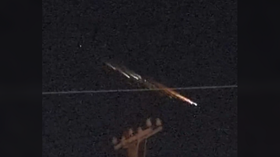Astronomers discover largest ever cosmic explosion

A team of astronomers have identified what they believe to be the largest cosmic explosion ever witnessed. Located billions of light years away in outer space, the blast is 100 times the size of our solar system and has grown in intensity over three years.
Having initially gone unnoticed by human observers, the event was picked up in 2020 by the Zwicky Transient Facility in California, which monitors the night sky for sudden increases in brightness. Researchers pored over data from the facility the following year, before a team led by astrophysicist Philip Wiseman at Britain’s University of Southampton tracked it with their telescopes.
When Wiseman’s team discovered just how far away the explosion was, its full scale became apparent.
The blast – known as AT2021lwx – is located 8 billion light years away from Earth, meaning it must have taken place when the universe was only 6 billion years old. “We’ve estimated it’s a fireball 100 times the size of the solar system with a brightness about two trillion times the sun’s,” Wiseman told The Guardian on Friday. “In three years, this event has released about 100 times as much energy as the sun will in its 10 billion-year lifetime.”
AT2021lwx is not the brightest cosmic event ever recorded. That title is held by a gamma-ray burst known as GRB 221009A, which was recorded by a NASA satellite observatory last year.
However, GRB 221009A lasted for ten hours, while AT2021lwx has been burning for three years, and is still increasing in brightness, all at three times the distance from Earth as GRB 221009A.
Wiseman’s team deduced that the explosion is too big to have been caused by an exploding star, or supernova. The next most likely scenario, they wrote in the Monthly Journal of the Royal Astronomical Society, was a ‘tidal disruption event’, in which a star is pulled apart by a giant black hole.
However, if AT2021lwx were caused by such an event, it would have required a star up to 15 times the mass of our sun. Given the rarity of such stars, the researchers have theorized that the explosion was triggered by a supermassive black hole consuming an enormous cloud of gas around 5,000 times larger than the Sun.
Wiseman told France’s AFP news agency that while the theory is “fully plausible,” the origin of the explosion remains “an absolute puzzle.”













